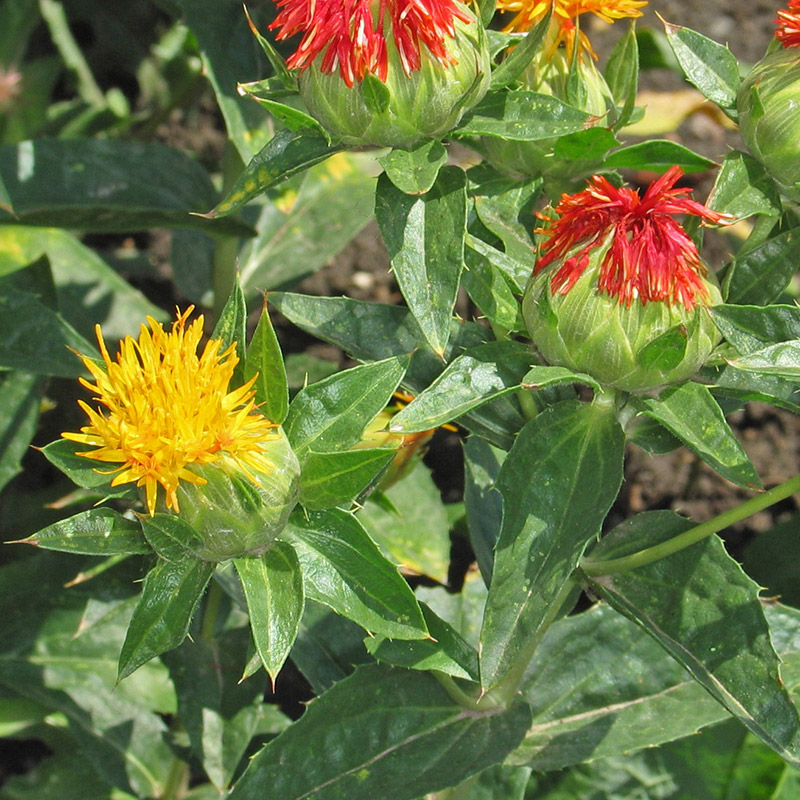Botanical name
Carthamus tinctorius L.
Family
Asteraceae
Common name
Safflower, Wild saffron, False saffron, Koosumbha, Hoang-tchi
Information about the plant
Safflower, also known as wild saffron or false saffron, is an ancient cultivated plant from the Middle East and Central Asia and was already used as a dye plant in ancient times. Nowadays, it is widespread in warm temperate regions and cultivated in many southern countries as a source of safflower oil from its seeds. Before the advent of synthetic aniline dyes, the orange-red petals were used to dye textiles, as they contain a water-soluble red dye called carthamin or safflower red. Today, carthamin is still used to color food and cosmetics.
The botanical species name tinctorius (Latin = dyer), originally from the Latin 'tingere' (= to dip, soak, color), is due to the coloring properties of the flowers. Unfortunately, the petals are also used as an artificial version of saffron (“false saffron”). The similarity to saffron is also expressed in the plant's name “safflower”, a combination of saffron and flor (from the Latin “flos” = flower). “Thistle”, from its German name “Fäberdistel” (distel=thistle), refers to the appearance of the plant, as it has stiff, spiky leaves and large flower heads like a thistle.
The safflower is an annual plant, its up to 1 m high branched main shoot rises rapidly from a rosette of leaves. The leaves are elongated (10 to 15 cm), finely toothed, and run down the stem (“stem-embracing”). The thistle-like basket flowers are 3 to 5 cm in diameter, enclosed by the spiny-toothed bracts of the perianth. The numerous flowers protrude from the perianth as a dense cluster. These are five-lobed, initially golden-yellow tubular flowers with red edges; later, their color changes to orange-red. The fruit is a 6 to 8 mm long, egg-shaped, shiny achene with four longitudinal ribs. +flowering time is from August to September.
Medicinally used parts of plants (herbal drug)
The fatty oil obtained from the seeds by pressing and/or extraction with subsequent refining (refined safflower oil - Carthami oleum raffinatum) is used. The refining process removes undesirable substances affecting taste, smell, and color.
Imports come from India, the USA, Mexico, and Ethiopia.
In Traditional Chinese Medicine (TCM), the dried flowers of the safflower are also used (safflower flowers - Carthami flos).
Constituents of the herbal drug
Safflower oil consists of triglycerides with di-unsaturated linoleic acid (C18:2; 75 to 80%) and monounsaturated oleic acid (C18:1; 11 to 13%) as the dominant fatty acids. Other acids include palmitic acid (C16:0) and stearic acid (C18:0). It also contains vitamin E (mixture of α-, β-, γ- and δ-tocopherol) and sterols.
Safflower flowers contain the red dyes carthamin, neocarthamin, and carthamone, safflower yellow A and B, flavonoids, and polyins.
Quality of the drug
The quality of refined safflower oil (Carthami oleum raffinatum) and safflower flowers (Carthami flos) is specified in the European Pharmacopoeia (Ph. Eur.).
Medical applications
Recognised medical use
Safflower oil has not yet been reviewed by the HMPC or ESCOP.
Safflower flowers are used in Traditional Chinese Medicine (TCM), which cannot be discussed in detail here.
Due to its high content of unsaturated fatty acids, safflower oil is used internally as a dietary supplement to prevent arteriosclerosis (lowering cholesterol levels). It also has a mild laxative effect and is used to treat Crohn's disease. It can be used externally to heal wounds, scars, bruises, and sprains.
Traditional use
Safflower oil has not yet been classified as a traditional medicinal product within the terms of Article 16a of Directive 2001/83/EC.
Herbal drug preparations in finished dosage forms
Safflower oil in capsules is offered by various manufacturers as a dietary supplement and is also available as a cooking oil in various qualities.
Dosage
Safflower oil is part of a healthy nutritional program. If safflower oil is taken in the form of capsules, the dosage instructions should be followed: 0.5 to 1 g of oil 3 times a day.
Preparation of a tea
Not applicable.
Notes
Based on previous experience, no risk to pregnant women and children is to be expected when used as recommended.
Side effects
None known.
Interactions
None known.
References
Herbal drug monographs
WHO Vol. 3 (Carthamus tinctorius)
Further literature
Commentary on the European Pharmacopoeia (Refined safflower oil, No. 2088; safflower flowers, No. 2386)


